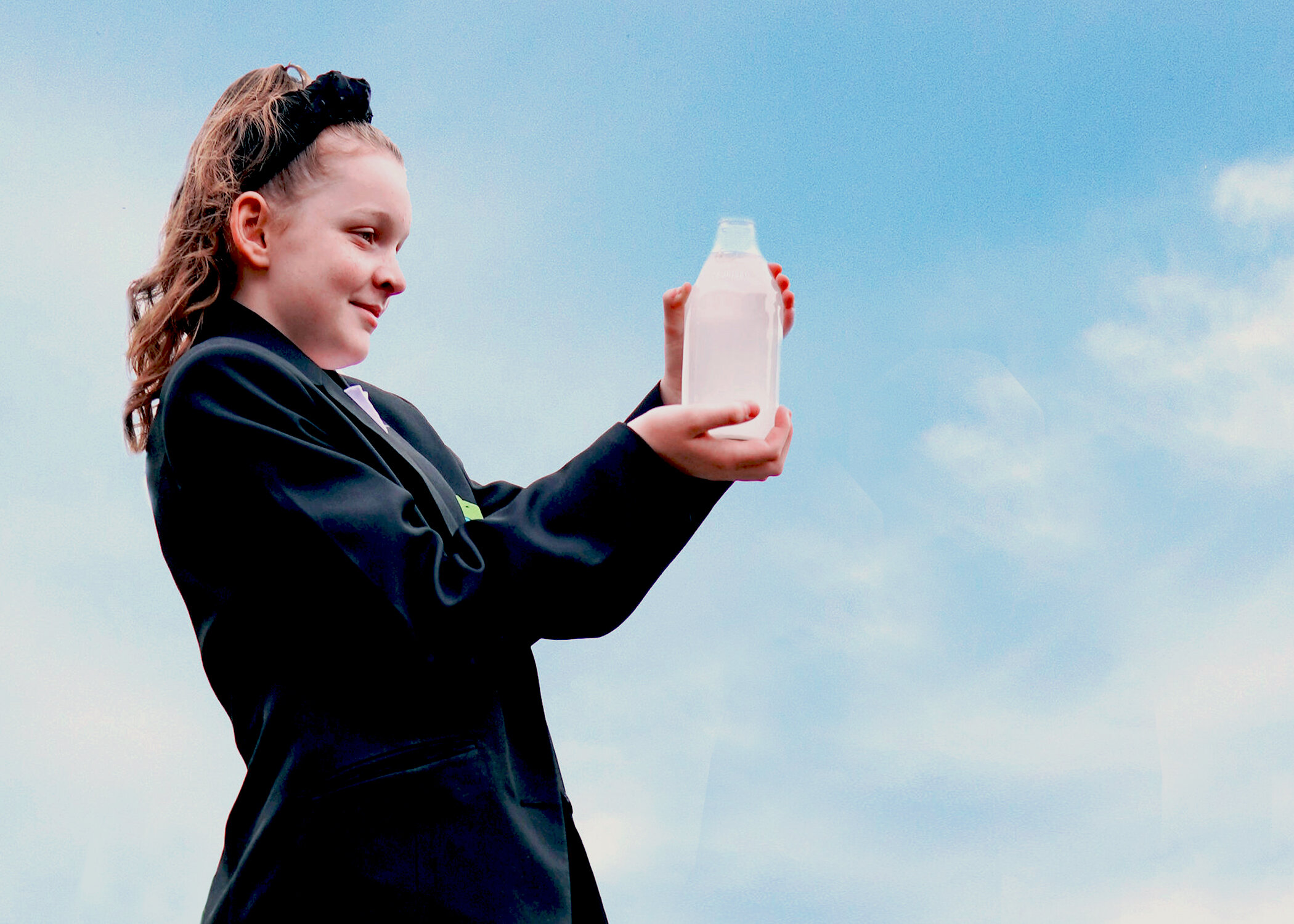This UK press campaign ran for two weeks.
Valued at over £250,000 it reached an audience of over 200 million.
Photographs - Usage cleared for all news media
B-Roll with GV’s - Usage cleared for news broadcasters
Press Release
MESSAGE IN A BOTTLE TO COP26 WORLD LEADERS
Science students from Stamford Welland Academy in Lincolnshire have captured the carbon dioxide driving climate change in a solution in a bottle, to present to the world’s leaders coming to COP26 in Glasgow in November. They’ve invited Alok Sharma, president of COP26, to receive the bottle, in the hope it can sit on his table throughout the conference making this invisible gas visible to all.
Their school climate project was steered by planetary scientists Claudio Vita-Finzi and John Marshall, of the SETI institute in California, to show one of the ways that carbon dioxide can be recaptured directly from the air.
The pupils designed their experiment around everyday household objects, including a simple solar powered garden pump and a solution of the drain cleaner - caustic soda. What’s more, the biproducts of their experiment could be reused by the food, paper and glass industries.
Stamford Welland Academy head of science John Hickman says: “I’m thrilled that the students have embraced this experiment which such enthusiasm. Using their science knowledge in this way is heartening to see.”
Ruby a 15 year old science student at Stamford Welland Academy says: “Our generation is often accused of jumping on the save-the-planet bandwagon, whilst not having realistic solutions to the problem. But we probably know more science than most of our parents.”
Professor Peter Styring, a leading researcher in carbon capture and a delegate at the COP26 conference says: “It’s vital that any sort of carbon capture solution like this harnesses a circular chemical economy, where the biproducts of the process are also put to good use. And whilst carbon capture technology alone is not going to save us from the effects of climate change, it must be in the mix for reaching our carbon zero target in the decades ahead.”
Stamford Welland Academy head Victoria Lloyd says: “We always encourage our students to look beyond Stamford and this has been a superb opportunity for them to get involved in a project which impacts the whole world. They are the generation whose lives will be most disrupted by climate change, which is why they have written to Alok Sharma in the run up to COP26, to have their voices heard as representatives of this generation.”
Professor Claudio Vita-Finzi says: “We are not the first people to have proposed this idea, but these students have proved its merit and shown it could be scaled up swiftly as one of the solutions to move us towards our net zero target.”
# # #
For further information, photographs, B-roll and interview opportunities please contact
Swainley Whipps Eden Entwistle at I AM SWEE: publicity@iamswee.com Tel: +44 (0)113 513 8760 Mob: +44 (0)7473 226221
NOTES TO EDITORS
WHAT DID THE STUDENTS DO?
The students from Stamford Welland Academy wanted to find out the best concentration of sodium hydroxide solution to most efficiently capture carbon dioxide from the air. They made up solutions of 10%, 20%, 30%, 40%, and 50% sodium hydroxide with distilled water, and then pumped air through them using electric pumps. As the solutions absorb the carbon dioxide from the air they gain weight. By weighing the solutions at the start of the experiment and then at regular intervals, they monitored when each became saturated with carbon dioxide, to work out which concentration performed best.
WHAT DID THEY DISCOVER?
Their results showed that at all dilutions a solution of sodium hydroxide absorbed carbon dioxide. Their 40% solution captured the most CO2. More dilute solutions simply take longer to trap the CO2. The students then ran a solar electrical pump, to push air through their sodium hydroxide solutions, powering their carbon capture process by Sunlight with no associated CO2 emissions.
HOW IS THE CARBON DIOXIDE CAPTURED?
A clear solution of sodium hydroxide turns cloudy as the carbon dioxide is captured, producing sodium carbonate. It takes less than two grams of sodium hydroxide to capture each gram of carbon dioxide from the air, making it one of the most efficient and cost-effective ways of trapping atmospheric CO2.
HOW COULD THIS IDEA WORK ON A LARGER SCALE?
Although carbon dioxide has a dramatic affect at trapping solar energy, there’s so little of this colourless gas in our atmosphere – just 0.04%, that it’s actually very hard to catch. Even scaling up the school experiment, you would need to pump 800 Olympic size pools of air through a tank of sodium hydroxide to capture one tonne of CO2 directly from the air. This would be very costly and energy intensive, and so it might be more efficient to use this method to absorb carbon dioxide directly from fossil fuel power station or steel factory emissions, where CO2 typically makes up 30% of the air. In such a setting you’d only need to pump one Olympic size pool of air through your sodium hydroxide solution to capture a tonne of carbon dioxide. Based on the chemical formula for sodium hydroxide - NaOH, the team call the experiment “NOaH”, because it could contribute to safeguarding life on Earth, and help protect coastal communities threatened by rising sea levels.
WHAT’S THE CARBON FOOTPRINT OF RUNNING THIS?
Manufacturing sodium hydroxide takes a lot of energy, and risks generating more CO2 than it could absorb. But progress is being made in its manufacture by solar power from the brine generated by desalination plants on the coast, especially in the Middle East, India and California.
# # #
For further information, photographs, B-roll and interview opportunities please contact
Swainley Whipps Eden Entwistle at I AM SWEE: publicity@iamswee.com Tel: +44 (0)113 513 8760 Mob: +44 (0)7473 226221
There have been many attempts over the years to trap CO2 directly from the air, some of which also use sodium hydroxide. But, to our knowledge, this is the first attempt to drive the process by solar power, resulting in a product that is economically valuable.
HOW MUCH WOULD IT COST?
The Stamford Welland Academy experiments showed that a solution of sodium hydroxide is both effective and cheap. Other direct air carbon capture technologies currently being trialled around the world cost between $300 and $600 for each tonne of trapped CO2. Given the efficiency of sodium hydroxide for capturing carbon dioxide it is estimated that the price for this method could eventually be well under $100/tonne; and some of these costs would be further offset by selling the biproducts and by novel sources of NaOH.
WHAT WOULD WE DO WITH ALL THE WASTE PRODUCTS?
The main biproduct of the school’s experiment - sodium carbonate, would enter a circular chemical economy, by being sold to the glass, paper and food manufacturing industries; which currently consume over 50 million tonnes of it a year. Another alternative to sodium hydroxide is calcium hydroxide – the biproduct of which - calcium carbonate, is already being used by a leading UK company to fabricate building blocks for use in the construction industry.
HOW MUCH CO2 DO WE NEED TO ABSORB TO MAKE A DIFFERENCE?
The total amount of carbon in the atmosphere has now doubled since the industrial revolution and sits at 875 billion tonnes. Each year human activity releases another 43 billion tonnes of carbon dioxide gas into our atmosphere. To make a meaningful difference, scientists think 5-10 billion tonnes of CO2 would need to be pulled out of the atmosphere every year over the next few decades. The NOaH system proposed here could be just one tool that we harness to reach this target.
WHY CAN’T WE JUST PLANT MORE TREES?
Trees are one of our best nature-based solution to absorbing carbon dioxide directly from the atmosphere, and we must encourage global tree planting projects. But it takes a lot of land, and years for trees to do this work. Forests then have to be protected for decades to prevent loss through fire. So it is important that we also create our own circular-chemistry carbon capture technologies, like NOaH to remove atmospheric carbon more rapidly and sustainably for generations to come.
IS CARBON CAPTURE THE ANSWER TO CLIMATE CHANGE?
Carbon capture is NOT going to save us from the effects of climate change alone. And we must all continue to set ambitious targets to phase out the use of fossil fuels for our transport, energy and food needs if we’re to mitigate the effects of our climate crisis.
# # #
For further information, photographs, B-roll and interview opportunities please contact
Swainley Whipps Eden Entwistle at I AM SWEE: publicity@iamswee.com Tel: +44 (0)113 513 8760 Mob: +44 (0)7473 226221
Stamford Welland Academy is a coeducational secondary school, located in Stamford in the English county of Lincolnshire and is part of Cambridge Meridian Academy Trust. The school has a passion and commitment to educating the ‘whole’ child and places a real focus on nurturing the well-being of the students in their care alongside providing a high-quality education. It is a school where all children, regardless of ability or background, achieve above and beyond their potential.
The Academy’s science department is extremely strong, with five members of staff, all with their own area of expertise. They were recently celebrated in the latest OFSTED report as one of the school’s great strengths. Science is such a fundamental part of the school’s curriculum that the Academy is about to invest in building two brand new, state of the art science teaching labs.
THE SETI Institute is a not-for-profit research organization whose mission is to explore, understand and explain the origin and nature of life in the universe, and to apply the knowledge gained to inspire and guide present and future generations. To this end, SETI’s research includes astrobiology, palaeobiology, radio astronomy, planetary geology, planetary exploration, exoplanet discovery, and evolution of solar system and exoplanet atmospheres. It employs over 90 scientists at its Headquarters in Mountain View, California.
# # #
For further information, photographs, B-roll and interview opportunities please contact
Swainley Whipps Eden Entwistle at I AM SWEE: publicity@iamswee.com Tel: +44 (0)113 513 8760 Mob: +44 (0)7473 226221






